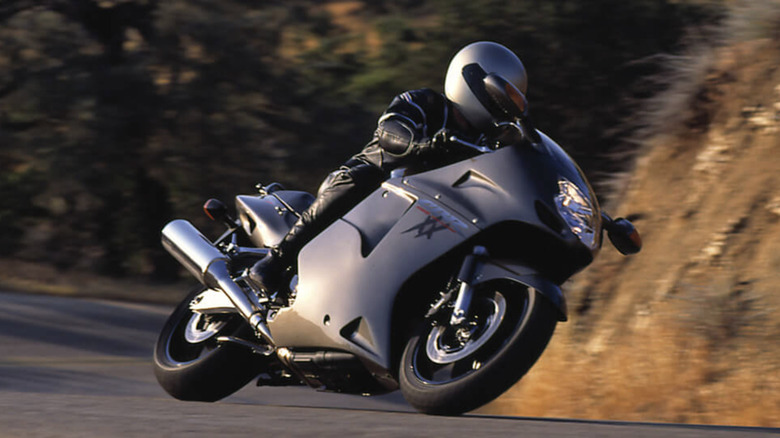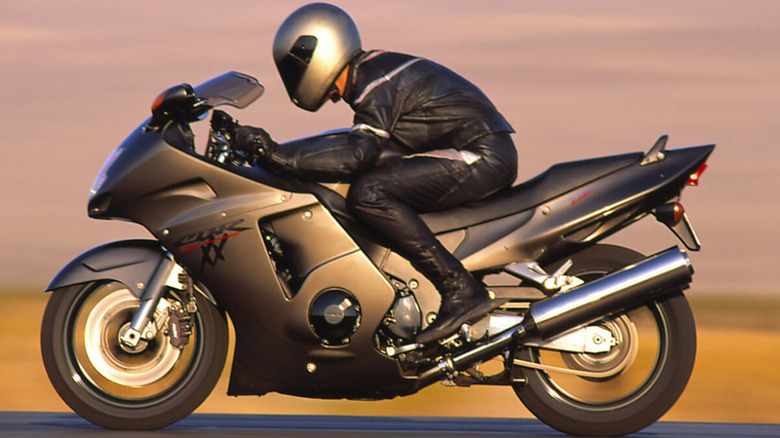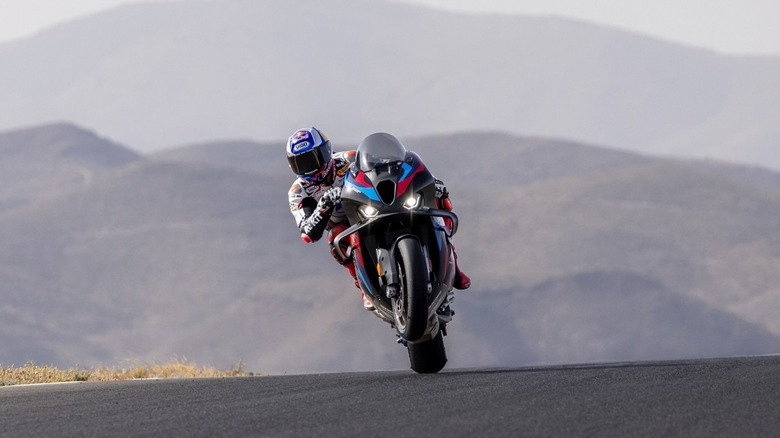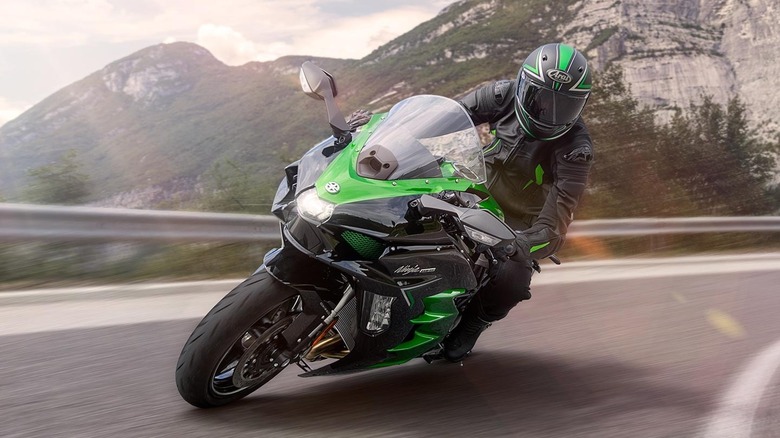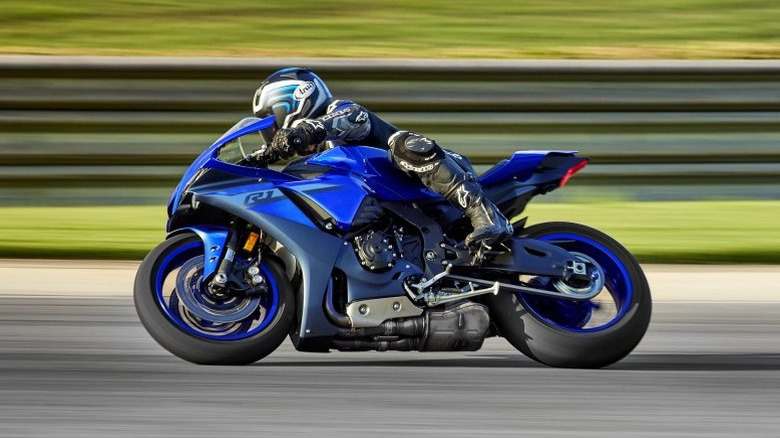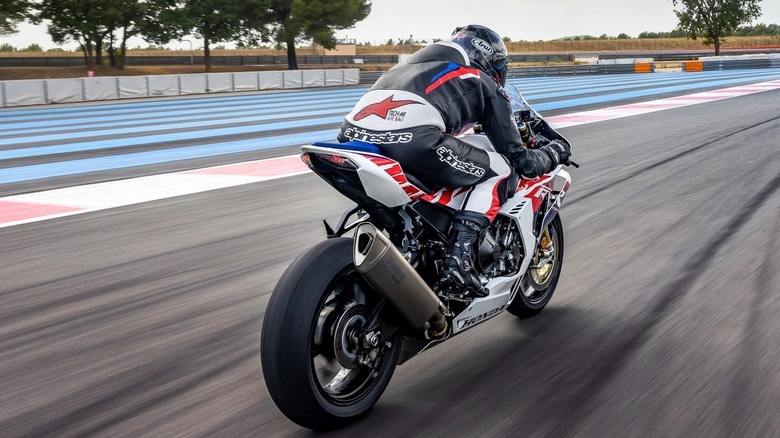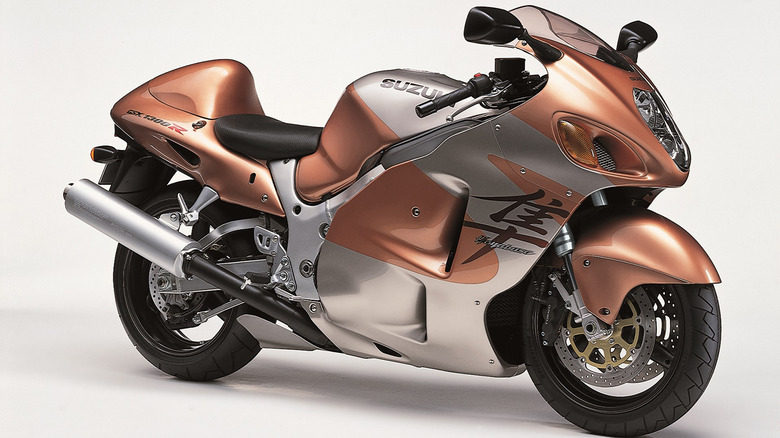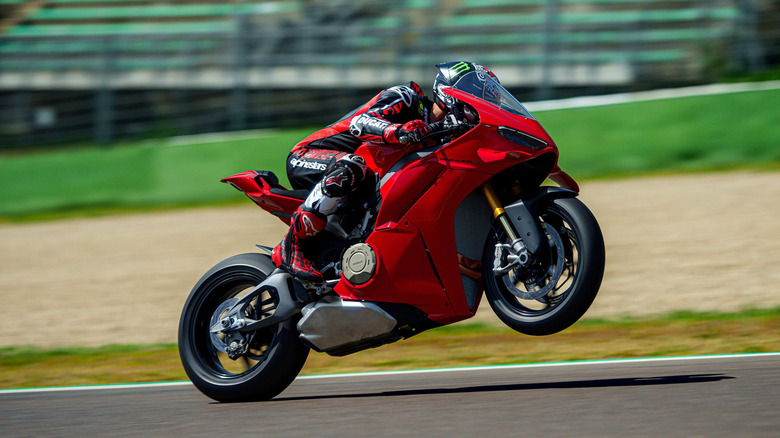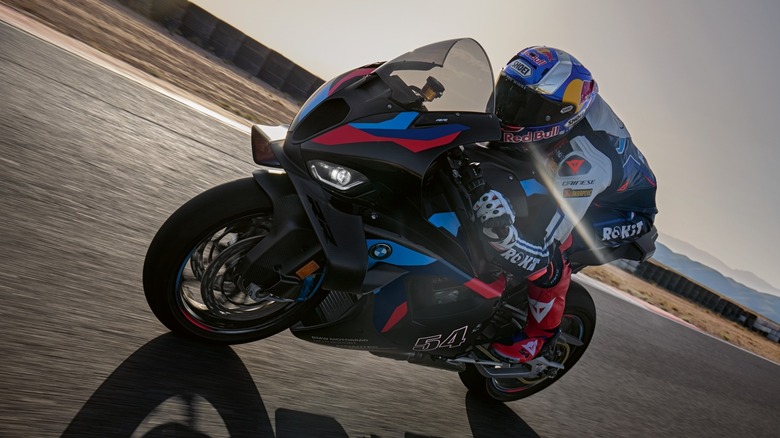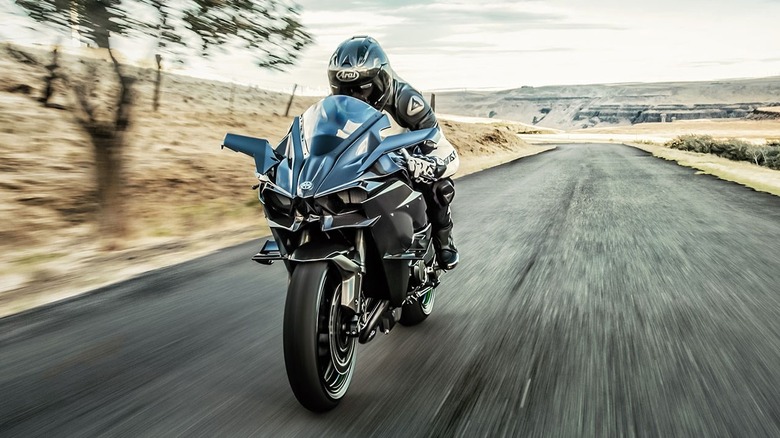The Unspoken Rule: Why Some Of The World's Fastest Motorcycles Are Limited To 186 Mph
In the late 1980s, Japanese car manufacturers limited their cars to a maximum of 276 hp. Often referred to as the Gentlemen's Agreement, this limit was imposed on cars by a few concerned automakers in an attempt to avoid a costly horsepower war. With increasing rates of road fatalities, and with high-performance vehicles becoming more and more common, they could also see the wagons of government regulation circling. So, before the government could step in, they decided to regulate themselves. Car manufacturers weren't the only ones to limit output though — motorcycle manufacturers saw the same writing on the wall and made a Gentlemen's Agreement too. Or at least that's how the story goes.
Around the same time that Japanese automakers limited cars to 276 hp and a top speed of 112 mph (numbers that were generally adhered to, but not regulated by any written law) motorcycle manufacturers were shooting for the moon. Bikes like the Honda CBR1000XX Super Blackbird and the Suzuki GSX-1300R Hayabusa were fighting for the top speed crown, inching dangerously close to 200 mph. Early Hayabusa models threw a big punch in the fight for top-speed champion, with an upper limit of 194 miles per hour until calmer heads prevailed. The motorcycle manufacturers decided to make a handshake deal of their own.
The motorcycle Gentlemen's Agreement
It's hard to nail down an exact date, but at some point in the late 1990s, when motorcycle manufacturers were going berserk with top speed numbers, the numbers stopped climbing. The generally-accepted timeline of events has bikes like the Kawasaki ZX-11 hitting a top speed of 283 kph (175.8 mph), then the Honda Super Blackbird broke through with a top speed of 287.3 kph (178.5 mph), and eventually the Hayabusa hit its 194-mph top speed. Not too long after that, the top speeds of all the fastest bikes began to match.
By the year 2000, the Hayabusa was limited to 186 miles per hour (299 kph) along with several other superbikes. According to lore, this was the result of a Gentlemen's Agreement similar to the one automakers had made just a few years earlier. Fearful of government regulation, Japanese motorcycle makers imposed a top speed limit on themselves. Some speculation has BMW facilitating these talks, but there's no hard evidence to support it. What is suggested, at least to some degree, is the fact that several motorcycles still have an electronically limited top speed of 186 mph today.
Does the Gentlemen's Agreement still exist?
I'd heard about this theoretical top speed of 186 mph more than once, but I wanted to see just how it manifested on different bikes and if anyone could confirm its existence. There's lots of conjecture about motorcycle top speeds, but not as much first-hand information as I'd like. So, I started my research about the Gentlemen's Agreement by looking at spec sheets. Immediately, I could tell that several manufacturers were outside the bounds of this limit.
MV Agusta released the F4 R 312 in 2007 with a top speed of 312 kph (194 mph). Clearly, it made no agreement — or maybe it was the first to break it. BMW lists the top speed of the S 1000 RR as 188 mphand it lists the top speed of their M 1000 RR at 189 mph. With videos online of unmodified S 1000 RR's hitting an indicated speed of 310 kph (192.2 mph), I figured BMW was ignoring any agreement, if there ever was one. At the very least, not all manufacturers were sticking to a strict number. With many of the major motorcycle manufacturers, however, top speed was omitted from their spec sheets entirely. Horsepower was missing too, especially on the fastest bikes and especially when it came to Japanese manufacturers like Honda, Suzuki, and Yamaha.
Kawasaki and the H2 lineup
When I was looking for information about the Gentlemen's Agreement, I spoke to several friends and motorcycle journalists with lots of seat time on these ultra-powerful bikes, seeing if they knew anything about the hush-hush top-speed agreement. According to one friend who had tested the Kawasaki Ninja H2SX years ago, it "hit 186 like a freight train. It's not drag limited, not even close." What he was saying, was that the power was there to go much faster 186 mph, but electronics limited the bike's top speed artificially.
Kawasaki's H2 bikes use a supercharged four-cylinder engine that produces 239 horsepower in its street-going bikes and 321.5 hp in the track-dedicated version, the utterly unique H2R. For street bikes, that's a massive amount of power. Even videos of riders topping out Kawasaki's less-powerful ZX-14R had it hitting the limiter at 299 kph. Videos of H2s out on the Autobahn confirmed that 299 kph was where the speedometer stopped counting on that bike too. But I already knew that the H2R's engine was capable of much more. A few years ago, motorcycle racer Kenan Sofuoğlu took an H2R up to 248 mph on a bridge, proving to me that I could cross Kawasaki right off the list. But what about less-powerful superbikes? Next, it was time to break out the rolodex and start asking some questions directly to the motorcycle manufacturers – or at least their PR reps.
Yamaha and the R1
Do even a surface-level search on YouTube for top speed runs and you'll find plenty of riders brave enough to test out whether or not the Yamaha R1 has an electronically-limited top speed – many of whom find a speed governor at 299. Find a road that's long enough and it's possible to hit that speed on many modern liter bikes, R1 included. Yamaha, I thought, would certainly have this sort of information somewhere on its website. With a bike as popular with track-rats as the R1, I was sure they'd list top speed numbers. And even if it didn't list it on its website it'd be able to tell me about the top speed of the venerable R1, or at the very least, the race-bred R1M. No dice.
When asked, Yamaha's PR team said that they "do not specify top speed numbers." When I pressed, asking why they don't report those numbers and whether or not it had to do with a Gentlemen's Agreement, they responded with: "For the same reason Yamaha doesn't report Horsepower numbers, different testing environments may yield varying results." Then, from the PR representative, a simple "I don't have any information regarding a Gentleman's Agreement." I guess it was time to consider that door closed.
Honda's CBR1000RR-R is faster than they say it is
Honda has a long history of fast motorcycles and with their involvement in the speed war of the 1990s, I was reasonably certain that I could get some information about their motorcycle's limits. I was right. Honda was quick to respond to my questions about the CBR and its top speed. After a few back-and-forth emails, Honda confirmed the top speed of the CBR1000RR-R was 185 miles per hour. Hmm, that's curious. While not the exact same 186-mph number that the Agreement supposedly limited bikes too, it was pretty close. "Why that particular speed?" I asked. A few emails later, Honda's representative confirmed that it wasn't electronically limited – that was just the top speed.
At this point, my suspicious nature brought me back to YouTube, where I found more than one CBR1000RR-R that displayed a top speed of 299 kph but potentially went much faster. In several instances, riders got the CBR up to its indicated top speed of 299 kph and the bike kept going. They'd hit 299 kph in fourth gear, then keep on accelerating through fifth and sixth. GPS read-outs from riders claim speeds as high as 346 kph – nearly 215 mph. In the 1990s, many of the 276-hp-rated cars were suspected of being much more powerful, with many making 300 to 350 hp. I suspect there's something similar going on with the Honda CBR1000RR-R and its indicated top speeds.
What about the Hayabusa?
When I asked Suzuki's representatives about the top speed of their bikes, or if any of them were electronically limited, they responded by saying "Most bikes are electronically limited to 186 mph. Unfortunately, [we] don't have any top speed figures to provide as it's not normally something we publish." I followed up, as was my general operating procedure at this point, asking more specifically about the Gentlemen's Agreement. After all, the Hayabusa was likely going to have a higher top speed than most bikes, right? It set the top speed record right before the Gentlemen's Agreement back in the 90s and with 1,340cc's of power on tap, it was bound to be faster than the 1,000cc bikes.
What response did I get from Suzuki when I followed up? "Unfortunately, [we] don't have any further information to provide at this time." Dang. Back to YouTube. In several videos of the Hayabusa making top-speed runs, I noticed the analog gauge cluster topped out just below 300 kph and it does so in fifth gear, with plenty of revs left to go. I did some deeper diving and found videos where "derestricted" versions of the bike topped out at 203 mph. There were also plenty of videos of modified Busas hitting insane speeds over 200 miles per hour, but no matter how entertaining those were to watch, they didn't answer any of my questions about the Gentlemen's Agreement.
Ducati said the quiet part out loud
When I reached out to Ducati, asking about the agreement and bikes like the Panigale V4, I was actually a bit stunned with their response. When asked about its fastest bikes it said, "Ducati does not declare top speed for any of our bikes." No big shockers there. "Our bikes are not electronically limited for top speed in any country. The Panigale V4, though, stops displaying the speed after 299 km/h – the bike continues to accelerate, but the cockpit displays three dashes '- – -'." This was basically what I'd found with most other superbikes, and confirmed with videos of the V4 maxing out online, but it was much more detail than other manufacturers had given me.
After a few more follow-up questions, though, Ducati gave me a delightfully thorough response regarding the Gentlemen's Agreement. "Several motorcycle manufacturers agreed that pursuing top speeds was impractical and dangerous. An informal agreement was reached to avoid speeds exceeding 300 km/h." Excelsior! Finally, a manufacturer had told me that it was part of some sort of agreement! Ducati continued, "Manufacturers adopted different approaches: some limited the speed [electronically, others] stopped displaying speeds beyond 300 km/h, and some ignored the agreement altogether." This was exactly what I was looking for. First-hand experience with the methods used to limit speeds on motorcycles and directly from an OEM. Gentlemen's Agreement: confirmed.
More on Ducati's approach to the Gentlemen's Agreement
After a lot of research, many attempts at contacting manufacturers, and lots of "sorry, never heard of it" responses, I was very happy to get an in-depth response from the folks at Ducati. On top of the previous information about its approach to the Gentlemen's Agreement, it also had this to say: "Eventually, some manufacturers returned to unrestricted speeds. Ducati, however, maintained its approach of disabling speed visualization beyond 299 km/h because indication beyond that is not helpful. On a racetrack, a conventional speedometer isn't precise enough for valuable data, especially when changes to the final drive ratio affect the dashboard reading."
They continued, "Professional data logging relies on GPS instead. On public roads, exceeding 300 km/h is unsafe and impractical, making the display of such speeds unnecessary." This was not just the best response I received in all of my contact attempts with OEMs, it was a series of excellent points that gave me extra insight into the struggles of tracking speeds and displaying speeds above 186 mph.
More than just numbers
Ducati's response to my questions helped me realize something: there are safety implications when it comes to publishing motorcycle top speeds. If you put a number on a spec sheet, riders will eventually be driven to challenge it — no matter how high the number. Even if they do so in an environment that's safe and properly set up for top speed runs, there's the potential for all sorts of negative consequences. Motorcycle manufacturers likely keep that in mind when they omit the top speed of their fastest bikes from public-facing spec sheets.
On top of safety concerns, there's the fact that components wear at a different rate when used at high speeds. Take tires for instance – expensive, speed-rated tires are required for powerful bikes. Most sport bikes come with Z or Y rated tires, capping their speed regardless of how much power they're putting out. Putting tires rated for sustained travel at over 200 mph on a street bike, is likely to be prohibitively expensive. Then, as referenced by both Yamaha's and Ducati's responses to my questions, tracking speeds above 186 mph is difficult and costly – generally requiring the use of GPS. Weather, road conditions, and even rider weight can dramatically affect a bike's potential top speed too, and they're all outside the manufacturer's control.
So is there really a motorcycle Gentlemen's Agreement?
With all of the top-speed videos, I found of bikes blowing their reported top speeds out of the water, and with the various responses I received from motorcycle manufacturers when they were asked about the existence of a Gentlemen's Agreement, it was clear to me that some sort of limit was definitely been placed on bikes and their top speed in the past. Even if most manufacturers don't admit to being part of some inter-company pact, it's clear that these limits still exist today on a number of motorcycles. It's also clear, however, that those limits aren't universal.
Was there a secret agreement back in the 1990s to keep the top speed of the world's fastest bikes restricted? According to at least one motorcycle manufacturer, yes. Maybe it was MV Agusta busting through the limit in the early 2000s, or maybe, like the automotive horsepower agreement, some manufacturers simply never fell in line. Either way, the remnants of the Gentlemen's Agreement still exist today, even if not everyone is abiding by it.
